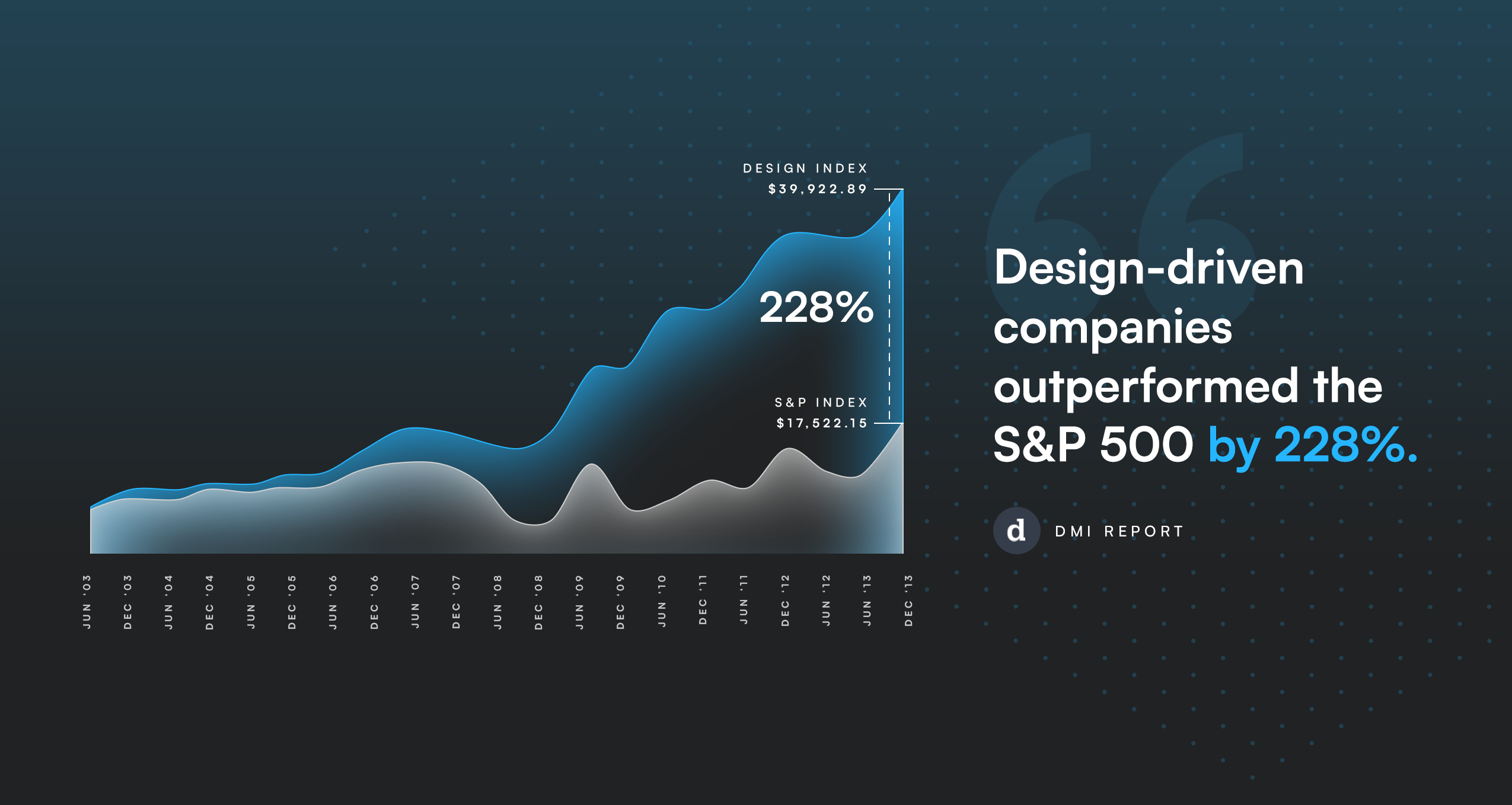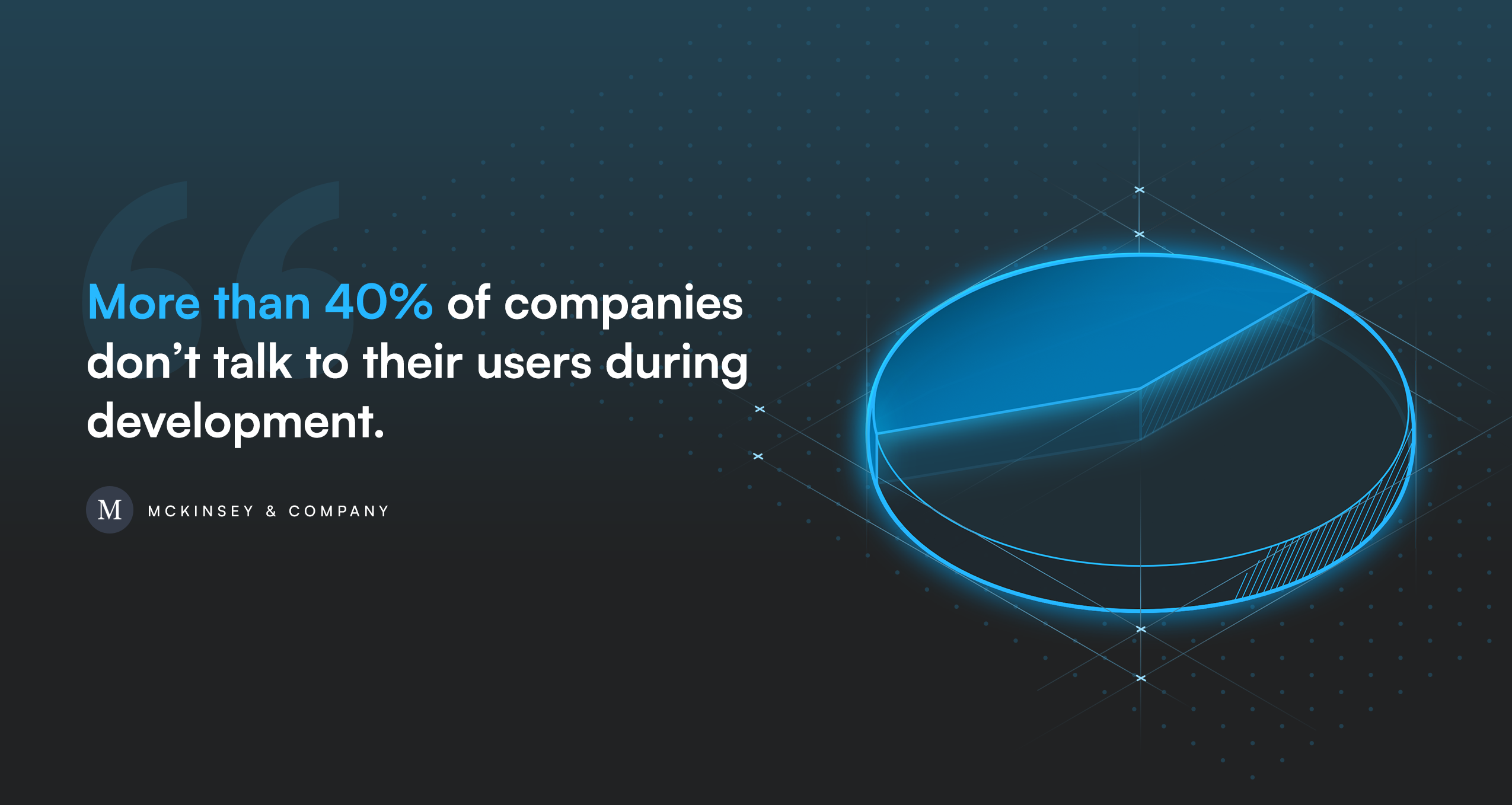Why “good” is not good enough

“Good” decisions lead to average outcomes. Here’s why you should never settle.
“With most things in life, the dynamic range between average and the best is at most 2 to 1.
In software, the difference between average and the best is 50 to 1, maybe even 100 to 1. Very few things in life are like this.”
— Steve Jobs
In design, the difference is 100 to 1.
The closer you get to 100, the more successful your business will become.
The problem is, most companies trend toward average. Less than 5% of business leaders can make objective design decisions. Their focus on “fast” and “cheap” threatens to compromise the quality at every turn, leading to outcomes that can only ever be “good”, at best.
But if you want to be an industry leader, good is not good enough. It could cost your company millions of dollars in potential income, or even make you obsolete.
Learn more about the power of design, and why you should aim for excellence instead.
The business value of design
“Design is more than a feeling: it is a CEO-level priority for growth and long-term performance.”
— McKinsey & Company
More than 95% of business leaders don’t understand the importance of design.
At least 50% admit they have no objective way to link design to business health, so they’re often reluctant to direct resources towards it.
But if you want to grow your business, increase customer loyalty, or outperform the competition, a design-driven approach will give your company the edge it needs.
The DMI Design Value Index found that over the last 10 years, design-driven companies outperformed the S&P 500 by 228%.

Only 15 of the 75 public U.S. companies they looked at met the design-led criteria, including Apple, Nike, Starbucks, Disney, and Herman Miller.
To be design-led, you have to focus on what your customers need. Your goal is to help them reach their goals. As fast and effortlessly as possible.
A customer-first approach is so effective that for every $1 invested into user experience, companies receive $100 in return — an ROI of 9,900%.

Forrester noted that “We’ve entered the age of the customer, an era when focusing on customers is more important than any other strategic imperative.”
Aim for top-quartile to avoid mediocrity
In the most extensive design study ever conducted, McKinsey spent 5 years tracking the design practices of 300 public companies, across multiple countries and industries. In total, they collected more than two million pieces of financial data, and recorded more than 100,000 design actions.
They created the McKinsey Design Index (MDI) to rate companies by how strong they are at design, then compared it to their financial performance.
McKinsey’s research found a strong correlation between high design scores and superior business performance. Companies that scored in the top quartile for design outperformed their industry counterparts by as much as 2 to 1.

The McKinsey Design Index focuses on 4 key areas that companies must excel in to join the top quartile:
- Analytical leadership. Measure your company’s design performance with the same scrutiny as costs and revenues.
- User experience. Put the user experience front and centre in the company’s culture.
- Cross-functional talent. Nurture your top designers, and empower them in cross-functional teams that take collective accountability for the user experience.
- Continuous iteration. Listen, test, and iterate with end-users from the first idea until long after the final launch.
McKinsey found that being in the top quartile for design matters whether your company focuses on physical goods, digital products, services, or any combination of the three.
But if you settle for average, or even good, your success is limited:
The total return to shareholders and revenue differences between the fourth, third, and second quartiles were marginal.
In other words, the market disproportionately rewarded companies that truly stood out from the crowd.
Why you should never settle for “good”
Every rushed release, every unresolved bug, and every compromise to the user experience pushes companies further back into the second, third, and fourth quartiles.
Compounded over time, “good” decisions create average outcomes.
“Good” limits your earning potential
80% of people will pay more for services with a better customer experience.
Most companies have no idea how much money they’re leaving on the table until they make design a priority.
When the USAA redesigned their website, they wanted to create a seamless experience for people to research, finance, and insure their vehicle purchases. The result: a 77% year-over-year increase in website visitors, a 15% increase in auto loans, and a 23% increase in vehicles sold.
BestBuy’s online experience was “good”, but it forced people to create an account before they could buy anything. It’s a classic example of putting business goals (collect user information) before user goals (buy something quickly), and an effective way to lose the sale. When they finally introduced the option to check out as a guest, it removed so much friction that people spent an additional $300 million per year.
“Good” tests customer loyalty

88% of people won’t return after one bad experience.
Loyal customers are more resilient, but not by much.
A study by PwC found that 59% of people will walk away from a brand they love after several bad experiences. Their tolerance is low: “bad” is still within the realm of what most companies consider “good”. While 89% of companies believe they deliver a superior service, only 9% of customers agree.
Aesthetic interfaces are not immune, either. One company lost 47% of their customers after a redesign that made their software look nice, but harder to use.
“Good” can be expensive for business

More than 40% of companies don’t talk to their users during development.
Most companies make “good” decisions to limit costs, reduce production time, and/or maximise short-term profits. But without a user-centric approach, they always pay more over the long term.
Ranked last in the American Customer Satisfaction Index, Sprint decided to change their approach. By eliminating the core issues behind customer support calls, they saved $1.7 billion per year and moved up the ranks to first place.
IBM analysed 225,000 employees based on whether their work computer was a Mac (usability-focused) or Windows PC (good enough).
Mac users were 22% more likely to exceed expectations in performance reviews, and generated 16% more sales than Windows users.
Windows users, on the other hand, increased the load on internal support systems:
- 40% of Windows users called the help desk, versus 5% of Mac users.
- One staff member can support 242 Windows users, or 5,400 Mac users.
- Over a 4-year time span, IBM saves $273-$543 per Mac.
How to achieve design excellence
The most successful companies are design-led. But if design thinking hasn’t penetrated the C-suite, adopting a design-led approach can be an uphill battle.
So what’s the most effective way to infuse design thinking into your company?
Tie executive bonuses (business goals) to usability metrics (user goals).
Before you make sweeping changes, McKinsey encourages companies to select an upcoming product or service they can use as a pilot to get the four design elements right.
For example, a medical equipment group decided to trial a design-led approach for a new surgical machine. Committed to the cause, the CEO tied executive bonuses to the product’s usability metrics and surgeon satisfaction scores.
To get to the right solution, the team created and iterated on more than 110 concepts and prototypes, and conducted more than 200 usability tests. The usability score of the final design exceeded 90%, while their competitors scored below 76%.
Over the next six months, the company’s market share increased by 40%.
Just like the medical group, incentivising a usability-first approach will increase your odds of success.
But design thinking requires more than just incentives.
The difference between average and the best is 100 to 1, so you still need the right people to see it through.
If you want to achieve software design excellence, consult with PARROT9.

